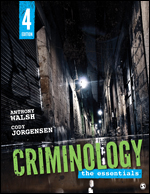Criminology
The Essentials
Anthony Walsh - Boise State University, USA
Jensten Cody Jorgensen - Boise State University, USA
INSTRUCTORS: Criminology: The Essentials is accompanied by a complete teaching and learning package! Contact your rep to request a demo.
- SAGE Premium Video
Theory in Action Videos and SAGE News Clips in the Interactive eBook boost student comprehension and bolster analysis. Watch a sample video. - Interactive eBook
Your students save when you bundle the print book with the Interactive eBook (Bundle ISBN: 978-1-0718-1338-6), which includes access to SAGE Premium Video and other multimedia tools. Learn more. - LMS Cartridge (formally known as SAGE Coursepacks)
Import this title’s instructor resources into your school’s learning management system (LMS) and save time. Don’t use an LMS? You can still access all of the same online resources for this title via the password-protected Instructor Resource Site. Learn more. - SAGE edge
This open-access site offers students an impressive array of learning tools and resources. Learn more.
Available formats
See what’s new to this edition by selecting the Features tab on this page. Should you need additional information or have questions regarding the HEOA information provided for this title, including what is new to this edition, please email sageheoa@sagepub.com. Please include your name, contact information, and the name of the title for which you would like more information. For information on the HEOA, please go to http://ed.gov/policy/highered/leg/hea08/index.html.
For assistance with your order: Please email us at textsales@sagepub.com or connect with your SAGE representative.
SAGE
2455 Teller Road
Thousand Oaks, CA 91320
www.sagepub.com
Instructor Resource Site
edge.sagepub.com/walshess4e
For additional information, custom options, or to request a personalized walkthrough of these resources, please contact your sales representative.
LMS cartridge included with this title for use in Blackboard, Canvas, Brightspace by Desire2Learn (D2L), and Moodle
The LMS cartridge makes it easy to import this title’s instructor resources into your learning management system (LMS). These resources include:
- Test banks
- Editable chapter-specific PowerPoint® slides
- Sample course syllabi
- Lecture notes
- All tables and figures from the textbook
You can still access all of the same online resources for this title via the password-protected Instructor Resource Site.
edge.sagepub.com/walshess4e
The open-access Student Study Site makes it easy for students to maximize their study time, anywhere, anytime. It offers flashcards that strengthen understanding of key terms and concepts, as well as learning objectives that reinforce the most important material.
- SAGE Premium Video in the accompanying Interactive eBook boosts student comprehension and bolsters analysis.
- Theory in Action Videos include candid interviews with former offenders and cement theoretical concepts for the students.
- SAGE News Clips showcase relevant news clips that deepen students’ understanding of key concepts and help students apply knowledge.
- Updated statistical information reflects the latest sources available, including Uniform Crime Reports (UCR), National Crime Victimization Survey (NCVS), and the National Incident-Based Reporting System (NIBRS).
- The latest developments in criminology include coverage of the Big Five Personality Traits and Cognitive Behavioral Therapy, as well as policies and strategies impacted by criminology, like target hardening for crime prevention, “Ban the Box” initiatives, gun violence policies, and issues with racial disparity in arrests.
- Current events in context cover challenging issues like the rise in right-wring extremism, recent terrorist attacks, the opioid epidemic, and the 2016 Brock Turner case and his 2018 appeal.
- New Pop Culture boxes tie the material to what is going on in today’s popular culture including entertainment, art, and current events.
- A substantive section on hate crimes added to chapter 3 brings into focus the extent of this crime and the recent increase in hate crimes.
- Revised chapters help students to better understand aspects of criminological theories and crime typologies.
KEY FEATURES:
- Chapter-opening learning objectives help students focus on the key forthcoming content.
- Chapter-opening vignettes draw students into the material and provide motivation for discussion.
- End-of-chapter summaries of theory tables ensure students understand the main differences between the theories.
- End-of-chapter Policy and Prevention sections describe the implications of each theoretical perspective.
- The Theory in Action boxes illustrate chapter material with interesting case studies that including review questions.
- Research Snippets of interesting research and Critical Thinking exercises encourage students to take a deeper look at the concepts and develop a more critical understanding of the issues.
- Key terms, discussion questions, web resources, and exercises at the end of each chapter provide additional opportunities for learning.

